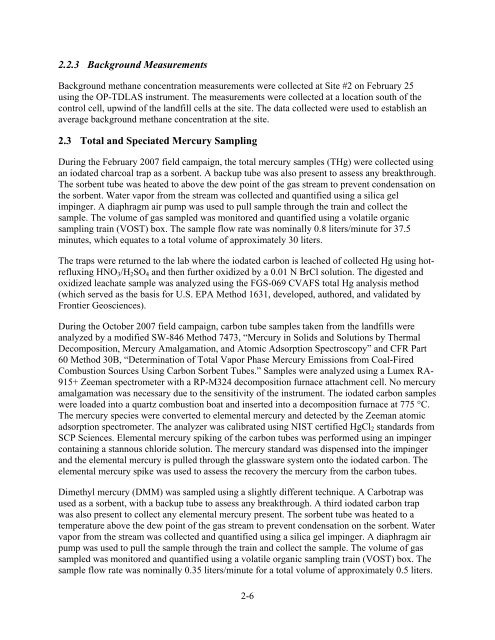Quantifying Uncontrolled Landfill Gas Emissions from Two Florida ...
Quantifying Uncontrolled Landfill Gas Emissions from Two Florida ...
Quantifying Uncontrolled Landfill Gas Emissions from Two Florida ...
You also want an ePaper? Increase the reach of your titles
YUMPU automatically turns print PDFs into web optimized ePapers that Google loves.
2.2.3 Background Measurements<br />
Background methane concentration measurements were collected at Site #2 on February 25<br />
using the OP-TDLAS instrument. The measurements were collected at a location south of the<br />
control cell, upwind of the landfill cells at the site. The data collected were used to establish an<br />
average background methane concentration at the site.<br />
2.3 Total and Speciated Mercury Sampling<br />
During the February 2007 field campaign, the total mercury samples (THg) were collected using<br />
an iodated charcoal trap as a sorbent. A backup tube was also present to assess any breakthrough.<br />
The sorbent tube was heated to above the dew point of the gas stream to prevent condensation on<br />
the sorbent. Water vapor <strong>from</strong> the stream was collected and quantified using a silica gel<br />
impinger. A diaphragm air pump was used to pull sample through the train and collect the<br />
sample. The volume of gas sampled was monitored and quantified using a volatile organic<br />
sampling train (VOST) box. The sample flow rate was nominally 0.8 liters/minute for 37.5<br />
minutes, which equates to a total volume of approximately 30 liters.<br />
The traps were returned to the lab where the iodated carbon is leached of collected Hg using hotrefluxing<br />
HNO3/H2SO4 and then further oxidized by a 0.01 N BrCl solution. The digested and<br />
oxidized leachate sample was analyzed using the FGS-069 CVAFS total Hg analysis method<br />
(which served as the basis for U.S. EPA Method 1631, developed, authored, and validated by<br />
Frontier Geosciences).<br />
During the October 2007 field campaign, carbon tube samples taken <strong>from</strong> the landfills were<br />
analyzed by a modified SW-846 Method 7473, “Mercury in Solids and Solutions by Thermal<br />
Decomposition, Mercury Amalgamation, and Atomic Adsorption Spectroscopy” and CFR Part<br />
60 Method 30B, “Determination of Total Vapor Phase Mercury <strong>Emissions</strong> <strong>from</strong> Coal-Fired<br />
Combustion Sources Using Carbon Sorbent Tubes.” Samples were analyzed using a Lumex RA<br />
915+ Zeeman spectrometer with a RP-M324 decomposition furnace attachment cell. No mercury<br />
amalgamation was necessary due to the sensitivity of the instrument. The iodated carbon samples<br />
were loaded into a quartz combustion boat and inserted into a decomposition furnace at 775 °C.<br />
The mercury species were converted to elemental mercury and detected by the Zeeman atomic<br />
adsorption spectrometer. The analyzer was calibrated using NIST certified HgCl2 standards <strong>from</strong><br />
SCP Sciences. Elemental mercury spiking of the carbon tubes was performed using an impinger<br />
containing a stannous chloride solution. The mercury standard was dispensed into the impinger<br />
and the elemental mercury is pulled through the glassware system onto the iodated carbon. The<br />
elemental mercury spike was used to assess the recovery the mercury <strong>from</strong> the carbon tubes.<br />
Dimethyl mercury (DMM) was sampled using a slightly different technique. A Carbotrap was<br />
used as a sorbent, with a backup tube to assess any breakthrough. A third iodated carbon trap<br />
was also present to collect any elemental mercury present. The sorbent tube was heated to a<br />
temperature above the dew point of the gas stream to prevent condensation on the sorbent. Water<br />
vapor <strong>from</strong> the stream was collected and quantified using a silica gel impinger. A diaphragm air<br />
pump was used to pull the sample through the train and collect the sample. The volume of gas<br />
sampled was monitored and quantified using a volatile organic sampling train (VOST) box. The<br />
sample flow rate was nominally 0.35 liters/minute for a total volume of approximately 0.5 liters.<br />
2-6















